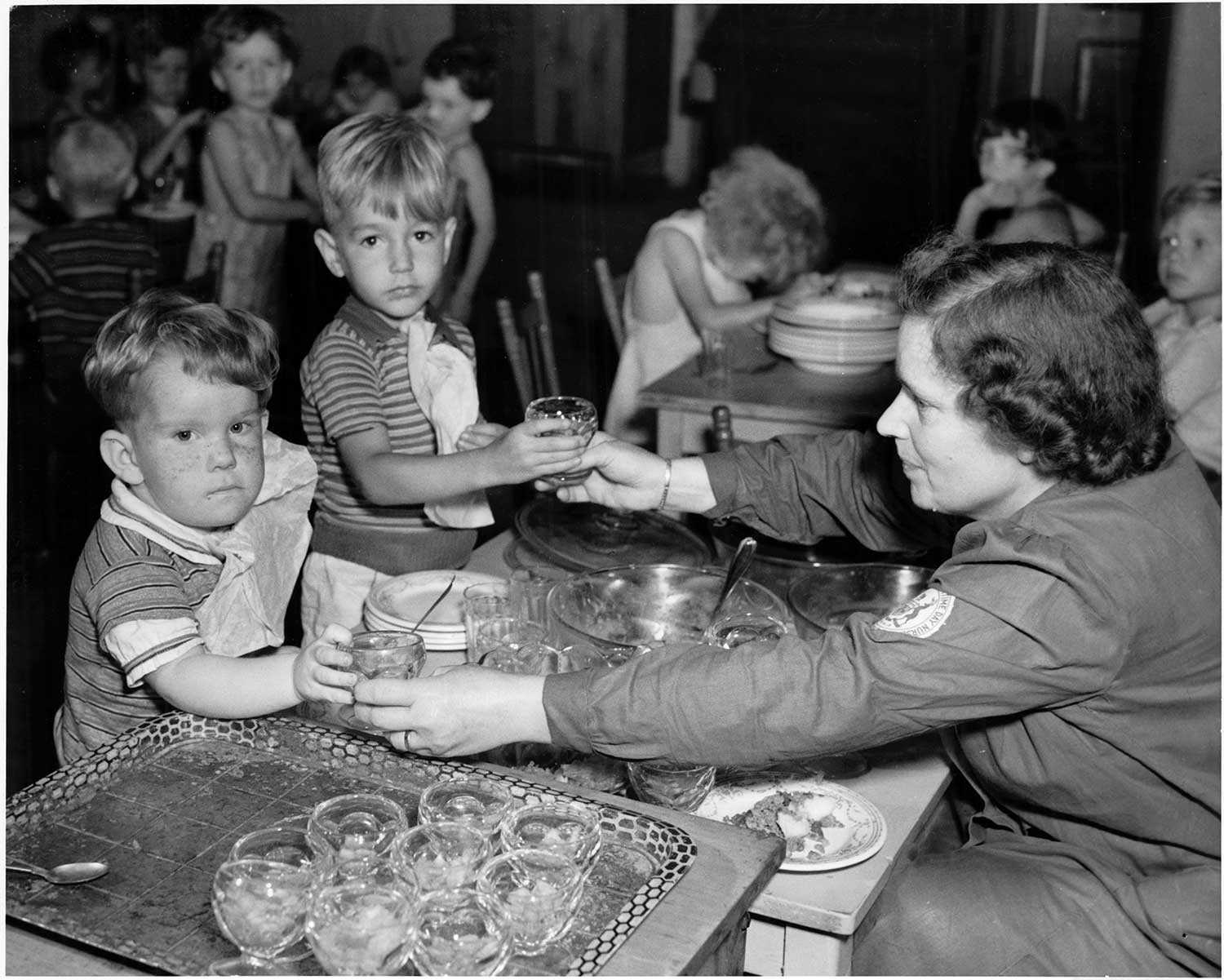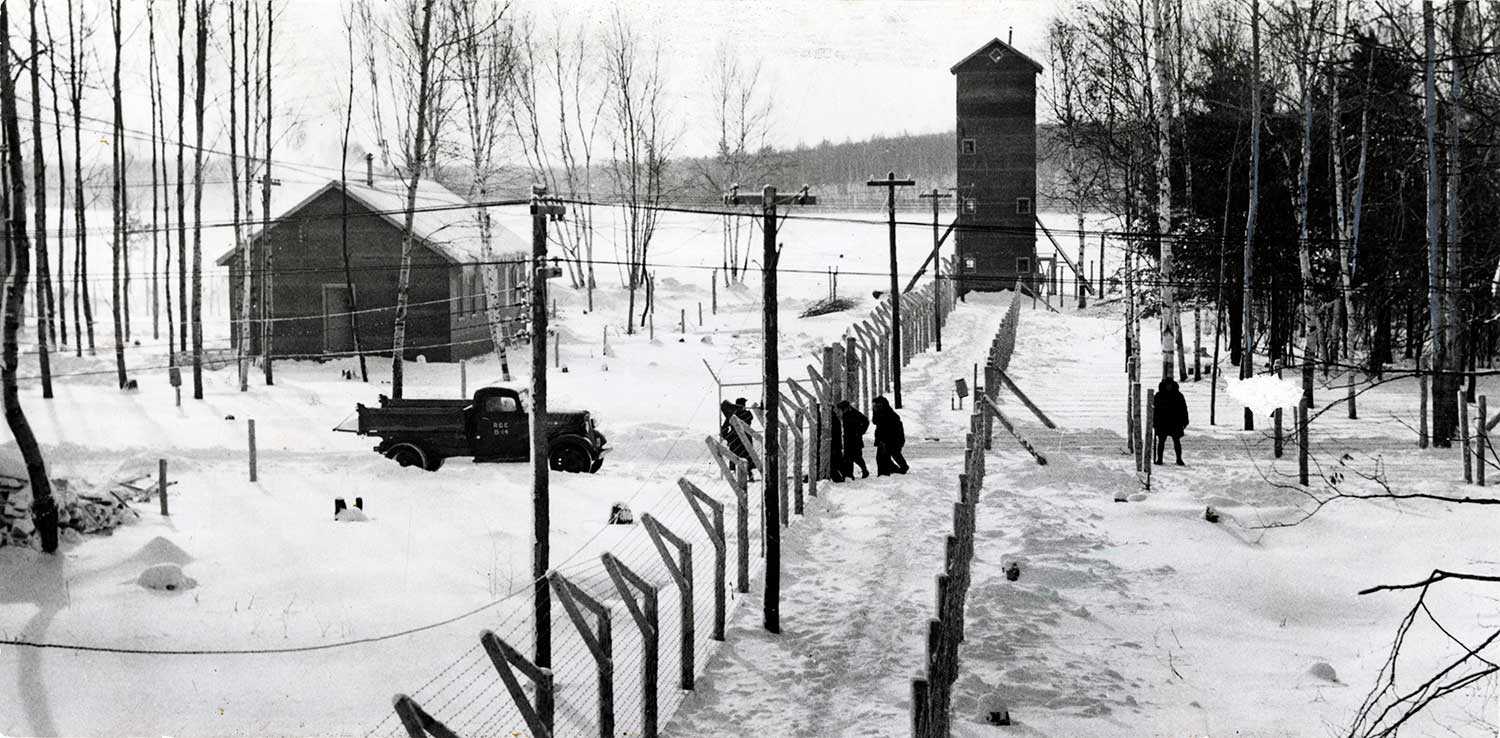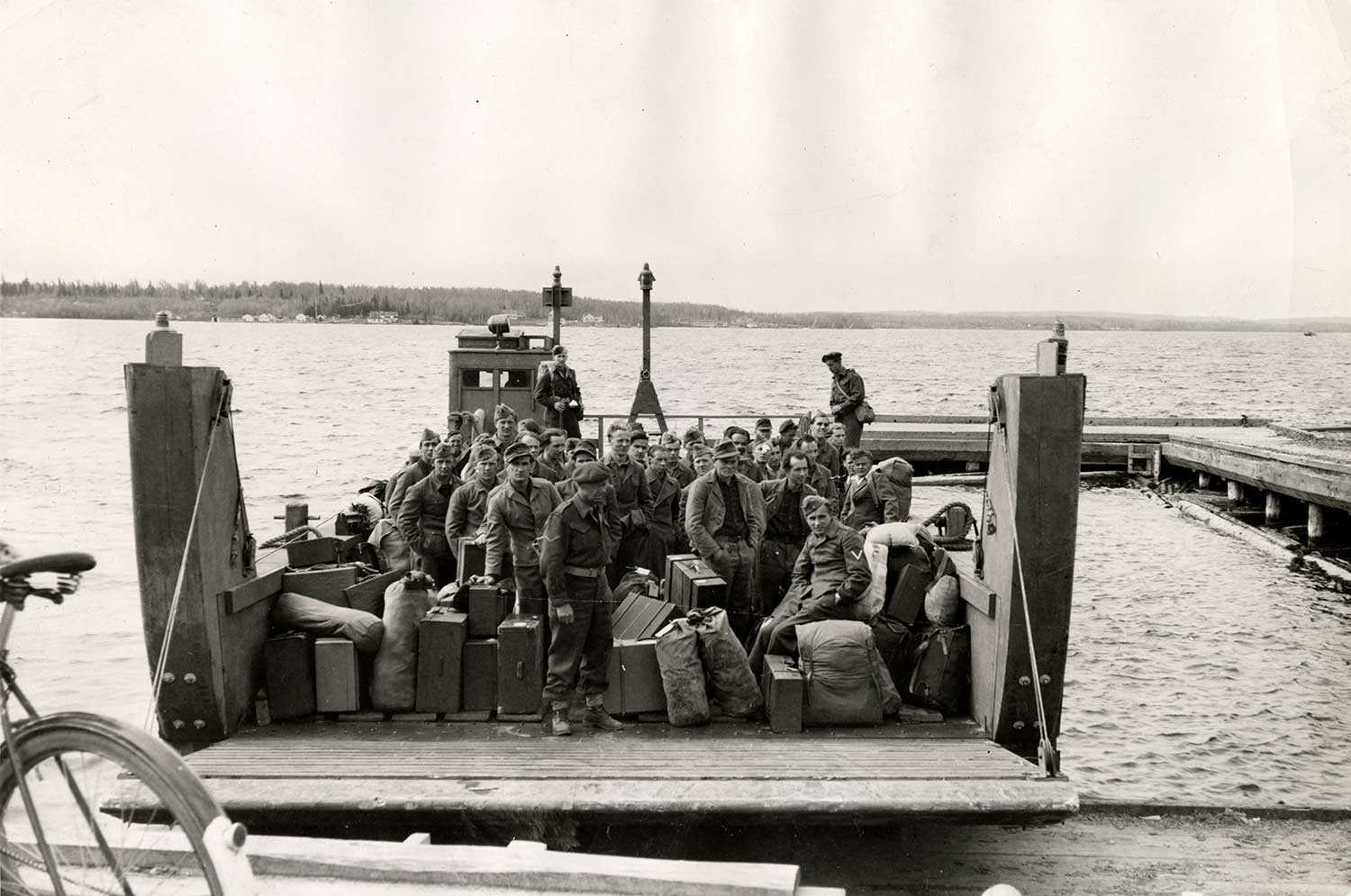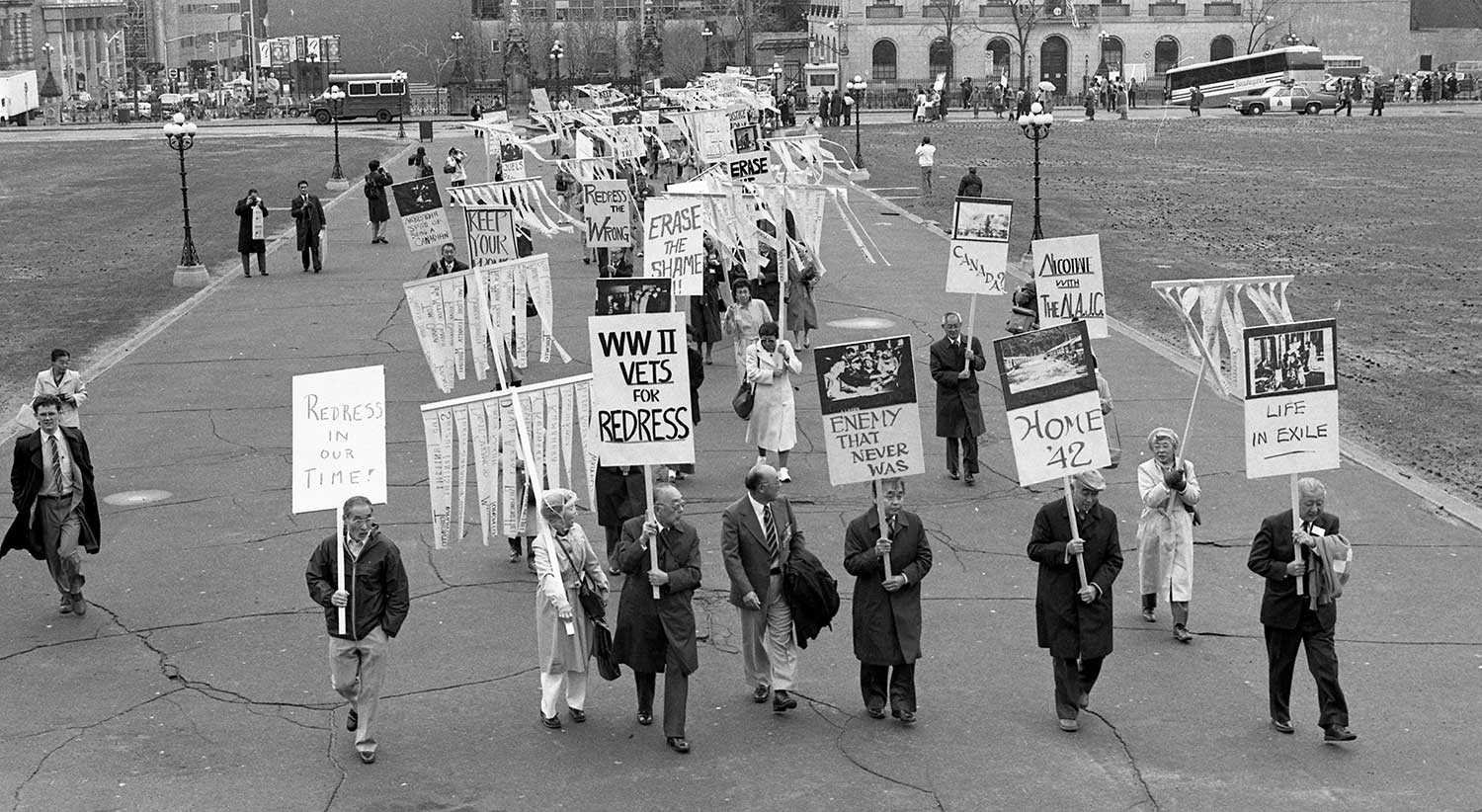Menu
Civilian victims of war
Introduction
Throughout the war, thousands of so-called “guest children” from the United Kingdom were brought to Ontario and other provinces until they could be reunited with their families under more stable and peaceful circumstances. Ontario, however, was not a refuge for everyone. The selection and screening of guest children were marked by racial and religious barriers. Social discrimination was also evident in Ontario’s internment camps. As a means of “protecting” Canada from the alleged enemies within, some Canadian citizens were indiscriminately stripped of their liberties and interned alongside Nazi sympathizers and prisoners of war. Among the internees were peaceful Japanese-Canadians as well as Jewish refugees fleeing Nazi persecution. As this section highlights, Ontario has a complicated history as a place of refuge and oppression during the Second World War.
Guest children
Following the United Kingdom’s declaration of war against Nazi Germany in September 1939, British parents feared for the safety of their children and sought to secure their refuge outside of Europe. Among their destinations were the United States and other members of the British Commonwealth, particularly Australia, New Zealand, South Africa and Canada. Before June 1940, the arrival of guest children in Canada was undertaken as a private affair. For the most part, these early evacuees were the children of affluent families who could easily afford passage and satisfied Canada’s restrictive immigration criteria. Social connections were valuable in this process. For instance, in September 1939, the University of Toronto’s Women’s War Service Committee initiated a private evacuation scheme. Members of the committee appointed to administer the program contacted their friends at British universities and facilitated the evacuation of their children. Under these and other private arrangements, 253 children under the age of 16 arrived in Canada in 1939. In addition, private schools from the United Kingdom relocated to Canada and brought with them hundreds of other British children.
After France’s defeat in June 1940, there was a massive surge in the number of British parents seeking to evacuate their children. Their desire to relocate their children intensified as the Battle of Britain began one month later. In response to the crisis, the Canadian government relaxed its financial and medical restrictions to assist evacuation efforts. Initially, these changes led to a surge in private evacuation. This prompted public scrutiny, however, which pressured the British government to initiate a public program for the evacuation of children. These responsibilities were given to the Children’s Overseas Reception Board (CORB). To qualify as one of Canada’s guest children, applicants had to meet discriminatory criteria involving race, religion and health. As per these requirements, Black and other “coloured” children could not qualify, nor could children with mental disabilities. Most Jewish children were also not welcomed through the CORB program. Representatives from Toronto – which at the time had the second-largest population of Jewish Canadians – were among the minority that pressured the Ontario government to accept Jewish children.

By the summer of 1940, roughly 211,000 children in the United Kingdom were under consideration by CORB, but only 24,474 were ultimately approved. The first ships carrying the successful applicants began their voyage in June, leading to the arrival of 1,532 children. Among their destinations was Ontario, which at this time had 5,000 approved homes. The children were first brought to a reception centre, such as Hart House at the University of Toronto, so that the children could be interviewed and receive a medical inspection. In addition to the official channels, an estimated 5,500 more children came to Canada through private arrangements.
Although parents intended to protect their children from danger, the voyage across the Atlantic was not without its own risks. On September 17, 1940, the passenger ship City of Benares was sunk by a German U-boat and resulted in the deaths of 73 CORB children. The tragedy had a significant psychological impact on British parents – who largely became reluctant to send their children overseas afterwards. As a result, the CORB program closed in early 1941. Similarly, British parents lost interest in private evacuation arrangements, and the number of guest children privately sent to Canada fell to 458 the same year. For the guest children who did complete their journeys to Ontario, they benefited from a more extensive public education than would have been received in the United Kingdom at the time. They also avoided mandatory service in British wartime programs, such as the Home Guard, though those determined to contribute to the war effort could do so in Canada. Many oral histories and memoirs of guest children recall their experiences in Canada as exciting and enjoyable, but at the war’s end, all but 205 CORB children returned home.
Internment
At the beginning of the war, Prime Minister William Lyon Mackenzie King’s government used emergency wartime powers to enact the Defence of Canada Regulations. Under these regulations, the government suspended civil liberties and had the authority to detain any individual – including citizens – acting in a “manner prejudicial to public safety or the safety of the state.” The Royal Canadian Mounted Police (RCMP), which had been conducting investigations prior to the declaration of war, immediately arrested 265 German nationals and 60 German-Canadians suspected of being Nazi sympathizers, saboteurs or enemy reservists. Many of those arrested in Ontario were detained in Toronto, where organized fascism was gaining traction. Detainees were then sent to Petawawa, which had operated as an internment camp during the First World War and a relief camp during the Great Depression. As another precaution, the Canadian government required that 16,000 unnaturalized German immigrants who had arrived after 1922 register with local authorities every month.
In 1940, internment operations expanded considerably. The number of alleged “disloyal” German and Austrian internees climbed to over 800 nationwide. In addition, Canada accepted 35,000 interned aliens and prisoners of war from the British government. The internees ranged from Jewish refugees (discussed below) to German soldiers and merchant seamen. Internment operations in Ontario also had to accommodate Italian-Canadian internees. Following Mussolini’s declaration of war on France and the United Kingdom in June, unnaturalized Italians similarly fell under the designation of “enemy aliens.” Under the authority of the Defence of Canada Regulations, 31,000 Italian-Canadians and Italian immigrants were forced to register, and 632 were detained. Joining them were 90 communists, who were initially housed at Petawawa alongside Nazi sympathizers.

To address this influx of internees, numerous internment camps were established in Ontario, including Mimico, Chatham-Fingal, Bowmanville, Fort Henry (the only internment camp with females), Gravenhurst, Petawawa, Espanola, Monteith, Angler, Neys and Red Rock. There were also two labour camps at Schreiber and White River, where internees worked on road construction projects that became the Trans-Canada Highway. Conditions in the camps varied across the province. In some instances, intolerable conditions provoked protests and revolts. Among the most notable was the so-called “Battle of Bowmanville” in 1942, whereby internees (many of them captured German soldiers and officers) staged a three-day revolt to protest the use of shackles.

Ontario’s internment facilities were also responsible for housing thousands of Japanese-Canadian internees. In 1941, over 90 per cent of residents of Japanese origin lived in British Columbia near the Pacific coast. The majority were born in Canada, and many more were naturalized citizens. There were no indications of disloyalty among the Japanese population, but after the Japanese Empire attacked Canadian troops in Hong Kong in December 1941, xenophobia in British Columbia intensified, and policymakers in Ottawa authorized oppressive regulations. Over 700 Japanese and Japanese-Canadian men were imprisoned. Residents of Japanese origin were ordered to routinely register with local police, but even more extreme was that nearly 21,000 residents of Japanese origin who lived within 160 kilometres (100 miles) of the Pacific coast were expelled from their homes. Their possessions ̶ including fishing vessels, automobiles and property ̶ were seized and auctioned off to help pay the costs of wartime internment. Following their displacement, Japanese-Canadian of all ages were forced to live in detention camps established in ghost towns, granaries, chicken coops and self-supporting communities.
In March and April 1942, hundreds of interned Japanese-Canadian men were sent to Ontario. Some arrived at either Schreiber to undertake road construction, while others went to Petawawa and Angler to live among German prisoners of war. Life in the camps followed rigid military routines. Occasionally, the Red Cross was able to provide simple comforts, such as cigarettes and reading material. As labour shortages in Ontario became increasingly acute in 1942 and 1943, some internees secured jobs as farm labourers and factory workers. After the war ended, over 13,000 Japanese-Canadians left British Columbia to escape its widespread nativism and xenophobia. The majority settled in Ontario, particularly in the southwestern region, where they worked in the fruit-growing industry. This post-war migration increased Ontario’s residents of Japanese origin from 132 in 1942 to 6,616 in 1947.

One social group that avoided internment but undertook labour service for the government was conscientious objectors (COs). Most COs came from Mennonites, Quakers, the United Church of Canada and Jehovah’s Witnesses. Following the introduction of conscription in 1940, the Ontario-based Conference of Historic Peace Churches and the Canadian government reached a settlement where COs would provide “Alternative Service” in exchange for exemption. The Alternative Service work camps began in late May 1941. In Ontario, the COs were put to work on similar projects as internees. For instance, a road camp at Montreal River was established to contribute to developing the Trans-Canada Highway. Other COs were sent to Glacier National Park in British Columbia as well as forest experiment stations in Alberta and Petawawa. By the spring of 1943, the majority of the COs were helping address the labour shortages in farms and factories. Nearly 11,000 COs worked in the Alternative Service program during the war – 2,636 were residents of Ontario.
Holocaust survivors
According to the 1931 census, Canada’s Jewish population was 155,614, which was 1.5 per cent of the national population. Montreal and Toronto were home to most. Although the history of Jewish migration dates to the 18th century, some Anglo-Canadians and French-Canadians considered Jews to be among the least desirable immigrants. Among those harbouring such a prejudicial view was the Minister of Mines and Resources, Frederick Blair, who was responsible for Canadian immigration between 1936 and 1943. Blair’s prejudice led to many restrictions that made it extremely difficult for most Jewish immigrants to enter Canada. Indeed, only 5,000 Jewish immigrants entered Canada between 1933 and 1947. On settling, Jewish immigrants continued to face discrimination in many areas of life, including job applications, access to recreational facilities and public spaces, purchasing property in specific neighbourhoods, and more. Jewish Canadians also had to cope with the antisemitism propagated by mainstream newspaper editorials, political officials and public figures. In some cases, antisemitism even led to violent confrontations. The largest-scale incident in Ontario was the Christie Pits Riot in Toronto on August 16, 1933. When Nazi sympathizers waved a Nazi flag at a baseball game to provoke the Jewish players, a fight erupted. It ignited long-standing tensions between Toronto’s ethnic communities and violence spilled into the streets. Although it is estimated that the riot involved over 10,000 people, no deaths resulted from the riot. Furthermore, there were only a few arrests made, but they included those accused of instigating the violence.
Watch this video from Historica Canada on the Christie Pits Riot.
Antisemitism never reached the widespread popularity and intensity experienced in Nazi-controlled Europe, but it was pronounced enough to deny Jewish refugees the opportunity to escape Nazi oppression. In early November 1938, Jewish homes, synagogues and businesses throughout Germany were ransacked as the Nazi government incited violence and commenced mass arrests of Jewish people. This Nazi-led violence, known as Kristallnacht (also called the Night of Broken Glass), was reported in Canada. Following this escalation of antisemitism, more Jews fled Europe. Among them were 937 refugees on the chartered ship St. Louis, which made the voyage across the Atlantic during the spring of 1939. When the St. Louis reached Havana, Cuba, officials there rejected the refugees despite their legitimate entry visas. Appeals were made to Prime Minister King to accept the refugees into Canada, but he deferred the issue to Minister Blair on the grounds of being preoccupied by the visiting British royal family. Tragically, the Jewish refugees ̶ including women, children and the elderly ̶ were refused entry. The St. Louis was forced to return to Europe and 254 of its passengers were killed during the Holocaust.
Despite the known persecution of Jewish people, Canada’s policies on Jewish refugees remained highly restrictive during the war. Only complete family units of immediate relatives were accepted. This would amount to a mere 153 families comprising 455 individuals throughout the entire war period. From this group, Toronto accepted 158. Another 2,284 Jewish male refugees arrived in Canada under a different pretext. Jewish refugees, mainly of German and Austrian origin, were perceived by the British government as a security threat and arrested. Thereafter, British officials sent the male refugees to Canada as part of an agreement to accept prisoners of war and so-called “dangerous enemy aliens.” When the interned refugees arrived in the summer of 1940, the Canadian authorities were surprised to find Jewish refugees, most of them between the ages of 16 and 20. Rather than release them, as pleaded by the British government, the Jewish men were sent to internment camps. In Ontario, these camps were located at Monteith and Red Rock. The internment facilities also housed Nazi sympathizers and captured German merchant seamen.
Life as an internee was a harrowing and degrading experience. It required hard physical labour for paltry wages. Sometimes, the intolerable conditions pushed internees to undertake desperate measures, such as strikes and insubordination. Eventually, camp conditions improved. By the end of 1941, most Jewish refugees were separated from the Nazi sympathizers and prisoners of war. The release of Jewish refugees gained momentum in 1943, but it was a gradual process that required external support from advocacy groups, relatives, sponsor families and prospective employers. Those who were released were put on “parole.” They were further restricted from speaking out against their treatment, nor could they travel or change jobs without approval. Marrying a Canadian woman to gain citizenship was also prohibited because the prospective wife would lose her citizenship. Not all the released Jewish refugees stayed in Canada. Driven by a desire to have a more direct contribution to the defeat of Nazi Germany, many returned to the United Kingdom and enlisted in the Auxiliary Military Pioneer Corps.
When Allied armies liberated Nazi concentration camps between July 1944 and May 1945, they obtained undeniable evidence that the Third Reich and its collaborators were systematically exterminating the Jewish people and other minority groups. Two-thirds of Europe’s Jewish population was murdered – a total of 6 million individuals. Entire towns disappeared from the map. The horror of the Holocaust became a driving force to end antisemitism and protect human rights during the postwar period. In Canada, a human rights revolution took shape among a wide range of supporters – the organized Jewish community among them. Their combined efforts gave tremendous weight to the liberalization of Canada’s immigration policies. Between 1947 and 1955, Canada accepted over 35,000 Holocaust survivors, their dependents and war orphans. Many settled in Toronto and contributed to the growth of the now-well-established and resilient Jewish-Canadian community.


